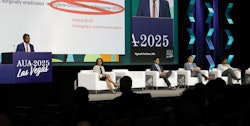Exploring the trade-off of new treatments for BCG-unresponsive NMIBC
Saturday’s debate surveyed the pros and cons of new bladder-sparing treatments for BCG-unresponsive non-muscle-invasive bladder cancer.

New options are available to help patients with Bacillus Calmette-Guerin (BCG)-unresponsive non-muscle-invasive bladder cancer (NMIBC) avoid or delay radical cystectomy.
“With a full armamentarium of agents with multiple mechanisms of action, it’s a game-changing era to preserve bladder and quality of life,” said Tullika Garg, MD, MPH, FACS, associate professor in the department of urology at Geisinger Health System. Dr. Garg moderated Saturday’s Plenary, “Controversies in Urology: Double Intravesical Chemotherapy Is Preferred Over New FDA-Approved Agents for BCG Unresponsive NMIBC: The Price of Success.”
To help you make informed treatment decisions, the session explored the pros and cons of double intravesical chemotherapy with Gemcitabine/Docetaxel (Gem/Doce) versus the new FDA-approved bladder-sparing treatments for BCG-unresponsive NMIBC.
Vignesh Packiam, MD, associate professor of urology at Rutgers Cancer Institute of New Jersey, set the stage by defining BCG-unresponsive NMIBC. Patient must meet two out of three criteria: They must exhibit high-grade papillary (TaT1) NMIBC within six months of last BCG, high-grade carcinoma in situ (CIS) NMIBC within 12 months of last BCG or high-grade T1 NMIBC recurrence at first (three months) evaluation after a single induction course of BCG. He presented data to build a persuasive case for Gem/Doce. “It’s widely available, well-tolerated, highly efficacious and cost-effective. That’s why it’s a no-brainer to give this treatment for patients with unresponsive disease,” Dr. Packiam said.
Shreyas S. Joshi, MD, MPH, assistant professor of urology at Emory University School of Medicine, presented the opening argument for the new FDA-approved agents, pembrolizumab (Keytruda), nadofaragene firadenovec (Adstiladrin) and nogapendekin alfa inbakicept-pmin (Anktiva), citing favorable data on prospective comprehensive outcomes reporting, side effects and long-term progression-free survival. “There’s no silver bullet for treating BCG-unresponsive disease, but these new agents offer the highest level of data, plus they capitalize on the immune sensitivity of bladder cancer,” he said.
William Huang, MD, urologic oncologist at NYU Langone Medical Center and the Perlmutter Cancer Institute, offered solid points for why Gem/Doce is still the preferred agent for NMIBC despite the explosion of new agents. From a cost standpoint alone, “Gem/Doce, at under $10,000 per year, is 20 times less than all the other agents,” he said.
“There is a cost for innovation,” said Cheryl Lee, MD, chair of the department of urology at The Ohio State University. “The novel agents approved by the FDA are potentially creating multiple lines of therapy for patients with NMIBC, particularly with CIS, with 89% cystectomy avoidance at 24 months.”
Which agent to choose? “All options incur costs in terms of financial, adverse events, treatment burden and clinical operations,” Dr. Garg said. “We need algorithms to sequence agents.”











